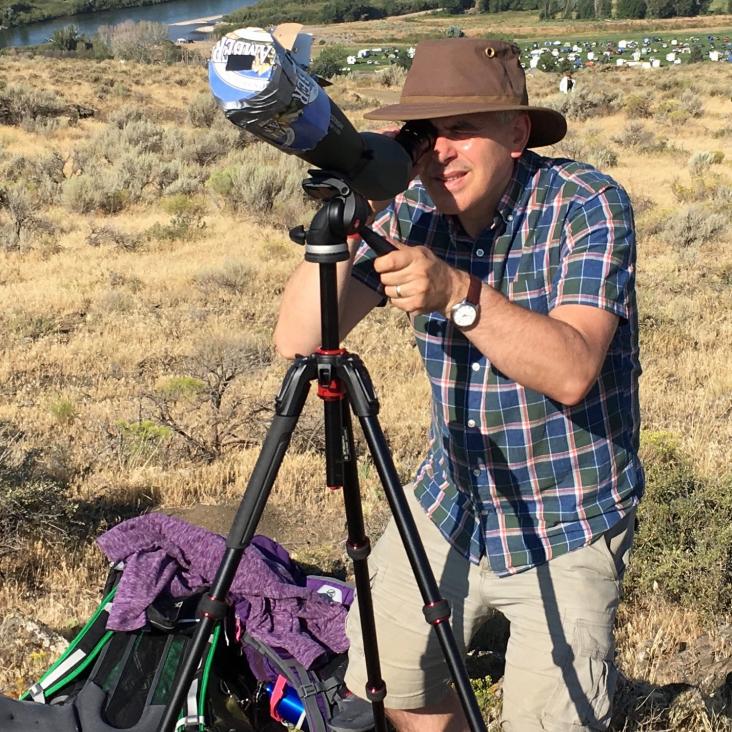Implementation of an optimized Cassegrain system for radio telescopes
Monthly Notices of the Royal Astronomical Society 384:3 (2008) 1207-1210
Abstract:
We present the antenna design for a radio interferometer, the Arcminute Microkelvin Imager, together with its beam pattern measurement. Our aim was to develop a low-cost system with high aperture efficiency and low ground spill across the frequency range 12-18 GHz. We use a modified Cassegrain system consisting of a commercially available paraboloidal primary mirror with a diameter of 3.7 m, and a shaped secondary mirror. The secondary mirror is oversized with respect to a ray optics design and has a surface that is bent towards the primary near its outer edge using a square term for the shaping. The antennas are simple to manufacture and therefore their cost is low. The design increased the antenna gain by approximately 10 per cent compared to a normal Cassegrain system while still maintaining low contamination from ground spill and using a simple design for the horn. © 2008 RAS.Radio source calibration for the Very Small Array and other cosmic microwave background instruments at around 30 GHz
Monthly Notices of the Royal Astronomical Society 388:4 (2008) 1775-1786
Abstract:
Accurate calibration of data is essential for the current generation of cosmic microwave background (CMB) experiments. Using data from the Very Small Array (VSA), we describe procedures which will lead to an accuracy of 1 per cent or better for experiments such as the VSA and CBI. Particular attention is paid to the stability of the receiver systems, the quality of the site and frequent observations of reference sources. At 30 GHz the careful correction for atmospheric emission and absorption is shown to be essential for achieving 1 per cent precision. The sources for which a 1 per cent relative flux density calibration was achieved included Cas A, Cyg A, Tau A and NGC 7027 and the planets Venus, Jupiter and Saturn. A flux density, or brightness temperature in the case of the planets, was derived at 33 GHz relative to Jupiter which was adopted as the fundamental calibrator. A spectral index at ∼30 GHz is given for each. Cas A, Tau A, NGC 7027 and Venus were examined for variability. Cas A was found to be decreasing at 0.394 ± 0.019 per cent yr-1 over the period 2001 March to 2004 August. In the same period Tau A was decreasing at 0.22 ± 0.07 per cent yr-1. A survey of the published data showed that the planetary nebula NGC 7027 decreased at 0.16 ± 0.04 per cent yr-1 over the period 1967-2003. Venus showed an insignificant (1.5 ± 1.3 per cent) variation with Venusian illumination. The integrated polarization of Tau A at 33 GHz was found to be 7.8 ± 0.6 per cent at position angle =148° ± 3°. © 2008 The Authors.The Arcminute Microkelvin Imager★
Monthly Notices of the Royal Astronomical Society Blackwell Publishing Ltd 391 (2008) 4
A high performance horn for large format focal plane arrays
Proceedings of the Eighteenth International Symposium on Space Terahertz Technology 2007, ISSTT 2007 (2007) 199-210
Abstract:
We describe the design and performance of an easy to machine horn which exhibits excellent beam circularity and low cross polarisation over a relatively large bandwidth. No grooves are machined into the horn walls but, alternatively, flare angle discontinuities are generated along the horn profile. In other words, the horns will have several flare angles or sections instead of one. For example, if the horn consists of two flare angles, it could then be considered as a conventional Potter horn. As can be seen below, even with this simple design, excellent radiation patterns can be obtained over 15% bandwidth. The bandwidth could be further increased by adding more subsections with 30% bandwidth obtained when the profile is based on 4 sections. The operation of the horn is based on generating higher order modes at the correct amplitude ratio and phase with respect to the incident TE11 mode in the circular waveguide, which is achieved by accurate determination of the magnitude and location of the flare steps. This in turn yields a field distribution at the horn aperture that has low sidelobes and cross polarization in the radiation pattern. A key component in the design package is the optimization software that searches for the correct magnitude and location of the flare discontinuities. We have generated a software package based on the combination of modal matching, genetic algorithm (GA) and simplex optimization. The genetic code is first used to locate the proximity of the global minimum. The set of parameters obtained are then used as a starting point for the simplex method, which refines the parameters to the required accuracy. We shall illustrate our method by showing radiation patterns using two and three step discontinuities and also patterns for a spline profiled horn based on work by other investigators who used different optimization techniques.Clover-measuring the CMB B-mode polarisation
Proceedings of the Eighteenth International Symposium on Space Terahertz Technology 2007, ISSTT 2007 (2007) 238-243


